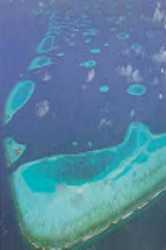|

Geography A long and narrow archipelago, the Maldives is about 820 km in length and 130 km in width at its widest point. It consists of 1,190 coral islands, which form a chain covering an area of 90,000 sq km of the Indian Ocean. Of this area only 300 sq km is land, the rest is sea, lagoon and reef.
The islands form 26 natural atolls. Most of the islands are quite small, some being mere sandbanks with a few shrubs. They are low lying with an average elevation of 1.6 m above mean sea level. Shallow, crystal clear lagoons enclosed by coral reefs surround the islands.
Climate The Maldives has a warm tropical climate characterized by much sunshine, with a rainy season from June to August. Flora and Fauna Maldives is home to some of the most exotic marine coral formations in the world. Multicolored tropical fish inhabits the reefs and shallow lagoons. The typical vegetation on land is the coconut palm. Water Water is a scarce resource in the Maldives. The islands depend on a thin lens of fresh water collected underground during rain showers. Traditionally it was this meager aquifer that sustained life in these remote islands. But with rapid development in the 1980s this was no longer sufficient. Ground water in the capital island Male became unsuitable for drinking. Now citizens of the island get piped de-salinated water. All the tourist resorts numbering over 80 also have their own supplies of de-salinated water. Lifestyle Male the capital is the only truly urban center in the Maldives. It is home to about 25% of the population. Most people in Male are employed in government service or in private businesses including construction work.
The roads of Male show glimpses of Maldivians going about life. First thing in the morning school children appear along with their gaily-dressed mothers. Then the office workers come in their motorcycles. You also see many cars and taxis. In the evening the youngsters come out in their stylish bicycles. A common scene these days is groups of expatriate workers who spend their free time in the parks and open spaces in Male.
75% of the population live in rural islands. Here life is more relaxed. The main occupation is fishing. These days an increasingly large number of the rural population are engaged in teaching and in the government services.
System of Government The Head of State and Chief Executive is the President who is elected every five years by a secret ballot in the Citizens Majlis, the unicameral parliament. The winning candidate needs to be approved in a national referendum before being declared elected.
The President appoints his Cabinet from among the prominent citizens of the country. Many ministers are members of parliament, though it is not mandatory.
Maldives is a member of the United Nations, the British Commonwealth of Nations, the Non-Aligned Movement, the South Asian Association for Regional Co-operation, the World Bank, the International Monetary Fund, the Asian Development Bank, the World Trade Organization and many other international organizations.
Education With over 95% literacy, the Maldives is one of the most literate countries in Asia. Primary education is universal and secondary education will also soon reach that target.
Recently Maldives established its College of Higher Education. It offers degree and diploma level courses.
Health The Maldives provides free primary and secondary health care to its citizens through a four-tier service delivery system. Tertiary care is provided at highly subsidized rates.
Maldives has achieved notable success in the field of health over the last 25 years. This includes the eradication of Malaria and universal immunization coverage.
Life expectancy is 71 years; the infant mortality rate is 25 per 1,000 live births. The ratio of physicians to population and the number of specialists compare favorably with those in most regional countries.
Welfare The government provides welfare assistance to those in need. Ministry of Womens Affairs and Social Security runs a home in a nearby island for people with special needs. The Ministry helps the poor to get medical treatment including referral abroad for specialized care. |




